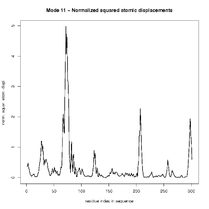Canavan Disease: Task 10 - Normal Mode Analysis
Normal Mode Analysis is a way to predict the dynamics behind a protein. Here elastic network models are used, since they are very memory reducing.
LabJournal
Background
There are several servers available, which can give some indication of the movement and dynamics within the protein. There are three main approaches to do this:
- Molecular Dynamics (MD)
- Normal Mode Analysis (NMA)
- Elastic Network Models
In Molecular Dynamics ...
Using Normal Mode Analysis the slow motions of a protein can be investigated. It is important to know that normal modes with the lowest frequencies (soft modes) are those representing the movements.
Elastic Network Models ...
To sum it up, What are the advantages and disadvantages of NMA compared to MD?
For this Task two servers WEBnm@ and NOMAD were used to calculate normal modes of aspartoacylase using the pdb-structure 2O4H. The severs provide different possibilities calculating the nomal modes. The next <xr id="servers"></xr> should give an overview of the differences and similarities between the servers:
<figtable id="servers">
| Differences and Similarities in WEBnm@ and NOMAD | ||
|---|---|---|
| Comparison | Webnm@ | NOMAD |
| Background (see References) | WEBnm@ is using the MMTK package: MMTK calculates the low-frequence domain movements using an approximate normal mode calculation method by Hinsen et al. 200 modes are calculated for proteins with less than 1200 residues. Proteins with more than 1200 residues (N>1200) will bring N/6 modes. Only the lowest frequency modes should be taken into account. Therefore WEBnm@ presents the modes 7-12 to its users. |
NOMAD makes its calculation using Elastic Network Models (or classical force fields): The Elastic Network Models (ENM) bring the advantage that a prior energy minimization to find the eigenvectors in the Hessian Matrix is not needed. The ENMs represent a set of harmonic potentials between atoms. This state represents the global minimum. Up to 160 modes are allowed to be calculated. The user has the possibility to choose how many modes. |
| Calculation implies the use of the Hessian Matrix, since its eigenvectors represent the normal modes. The first 6 (zero-frequency) modes represent the global rotation and translation of the protein | ||
| Which part of the structure is taken into account for the calculation? | C-alpha atoms only | |
| - | 2 further options: all atoms, sidechains only | |
| Which analysis tools are available? | visualization, fluctuations, eigenvalues | |
| deformation energies, atomic displacements, correlation matrix | frequencies, overlap coefficients, structure minimization using GROMACS (only structures with less than 3000 atoms) | |
| What options do I have? | choosing chain of protein, Comparative Analysis | Number of modes to calculate (first six ones are translation and rotation), distance weight (for elastic constant), ENM Cutoff (for mode calculation), Average Rmsd (in output trajectories) |
</figtable>
WEBnm@
- Visualize some modes (provided by server or using for example PyMol or VMD). Choose between 2-10 modes you believe are interesting and describe what movements you observe: hinge-movement, “breathing”…
- Which regions of your protein are most flexible, most stable?
- Define domains for your protein based on correlated motions using WebNM@. Compare to the CATH, SCOP and Pfam domains of your protein.
- Try the comparison/upload of second structure option, if: (i) you have PDB structures in different conformations or (ii) your protein has a bound ligand. Then either upload a structure with and one without the ligand, or delete the ligand in your structure. Note: Due to the force field that considers only C_alpha atoms, only changes in the backbone will give results. The model does not resolve changes in side-chain positions or SNPs.
- For WEBnm@ try the amplitude scaling and vectors option.
</figure>
</figure>
</figure>
|
<figure id="eigenvalues"> |
|
<figure id="correlation"> |
|
<figure id="correlation"> |
</figure>
</figure>
</figure>
</figure>
</figure>
</figure>
</figure>
</figure>
</figure>
</figure>
</figure>
</figure>
|
Mode 7: |
<figure id="mode7"> |
|
<figure id="mode7plot"> | |
|
Mode 8: |
<figure id="mode8"> |
|
<figure id="mode8plot"> | |
|
Mode 9: |
<figure id="mode9"> |
|
<figure id="mode9plot"> | |
|
Mode 10: |
<figure id="mode10"> |
|
<figure id="mode10plot"> | |
|
Mode 11: |
<figure id="mode11"> |
|
<figure id="mode11plot"> | |
|
Mode 12: |
<figure id="mode12"> |
|
<figure id="mode12plot"> |
NOMAD
Since there was a problem using the server, elNemo could not be taken into account. Therefore NOMAD was chosen to predict normal modes.
- Visualize some modes (provided by server or using for example PyMol or VMD). Choose between 2-10 modes you believe are interesting and describe what movements you observe: hinge-movement, “breathing”…
- Which regions of your protein are most flexible, most stable?
- Define domains for your protein based on correlated motions using WebNM@. Compare to the CATH, SCOP and Pfam domains of your protein.
</figure>
</figure>
</figure>
</figure>
</figure>
</figure>
</figure>
</figure>
</figure>
</figure>
</figure>
</figure>
|
Mode 7: |
<figure id="mode7"> |
|
<figure id="mode7plot"> | |
|
Mode 8: |
<figure id="mode8"> |
|
<figure id="mode8plot"> | |
|
Mode 9: |
<figure id="mode9"> |
|
<figure id="mode9plot"> | |
|
Mode 10: |
<figure id="mode10"> |
|
<figure id="mode10plot"> | |
|
Mode 11: |
<figure id="mode11"> |
|
<figure id="mode11plot"> | |
|
Mode 12: |
<figure id="mode12"> |
|
<figure id="mode12plot"> |
Comparison
- Can you observe notable differences between the normal modes calculated by the different servers?
References
official papers:
Tasks
- Link to Task 01: Canavan Disease
- Link to Task 02: Alignments
- Link to Task 03: Sequence-based Predictions
- Link to Task 04: Structural Alignments
- Link to Task 05: Homology Modelling
- Link to Task 06: Protein Structure Prediction from Evolutionary Sequence Variation
- Link to Task 07: Researching SNPs
- Link to Task 08: Sequence-based Mutation Analysis
- Link to Task 09: Structure-based Mutation Analysis
- Link to Task 10: Normal Mode Analysis


























